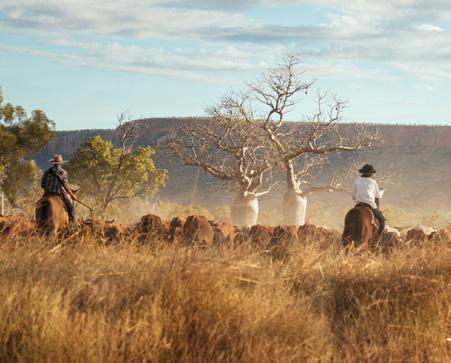
6 minute read
Life After Racing
TRAVEL
MAIN: An adventure in the Kimberley on horseback – what’s not to like? LEFT: Roderick stands on the drafting gate as sunlight cuts through the dust.
mainstay of a visit to Diggers.
Accommodation includes the Bunkhouse, bush huts and camp sites. The warm hospitality and the escape to a simple life are unchanged, and Alida is optimistic that Diggers will regroup in the current climate. “We’re leaning away from long camp treks, towards station-based riding,” she says. “That way we can still ride out every day over thousands of acres, but return to the station at night, and better manage the health and safety needs of our team and our guests. We’re also working on offering a cattle paddock-shifting experience as opposed to a traditional muster. It’s a little more subdued and again, easier to manage any restrictions or requirements that we need to.”
At the intersection of five rivers, Wyndham and its surrounds provides rich wildlife experiences. Diggers is located amongst golden spinifex ridges and grassy flats, with habitats that include rock escarpments, billabongs, flood plains and tidal mangroves. Over 140 bird species have been identified including the Spinifex Pigeon, White Quilled Rock Pigeon, and Red-Backed Fairy Wren, as well as the Masked, Long-Tailed, Star Crimson, Zebra, Double Bar and Gouldian finches.
For the keen angler, the Kimberley is in the heart of Barramundi country, and Diggers is renowned for its fishing. They grow them big in these parts with a 1.2 metre specimen recently caught in a nearby freshwater hole, although they can weigh in at 60 kilograms and reach 1.8 metres in length. presented by Rachel Dillon and Andrew Kikeros has been offered at Diggers for the last seven years, with a rota of arts practitioners facilitating photography, writing and painting workshops. As well as daily art sessions, riding, early morning hikes, fishing and overnight camps are peppered throughout to ensure visitors have plenty of opportunity to explore the vast station and surrounding natural wonders. Alida has high hopes to rejuvenate
Mustering at the tail of the herd.
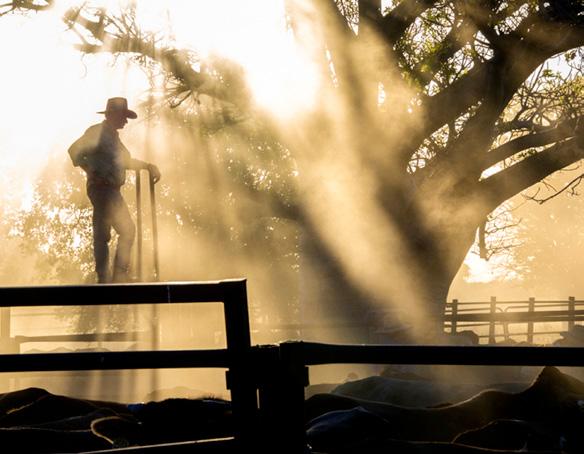
the series with visitors still booked in for next season. “It was amazing to have over a third of bookings defer to next season, and we expect to sell out, even with our new format,” she says.
If anything has cemented Diggers’ appeal and profile as an authentic outback experience, its starring role in Baz Luhrmann’s feature film Australia brought the station to global audiences. As one of the film’s locations, the natural actors included the Cockburn Ranges, visible from the doorstep, and the flat-top mountains that dominate Wyndham and Kununurra. Home to over 90 crew and cast for several weeks during filming in 2007, Diggers was transformed into a Hollywood set. Autographs of stars such as Luhrmann, Hugh Jackman, David Wenham and David Gulpilil still adorn the walls.
Beyond the starlight, open skies, and the forever horizons, there’s another layer to the romance of this place. In 1996 a young American woman with a pretty name was exploring the Kimberley with a friend in an old Subaru. Car trouble and circumstance led the pair to Diggers Rest Station where Alida met Roderick. She never left, and the rest, as they say in the classics, is history.
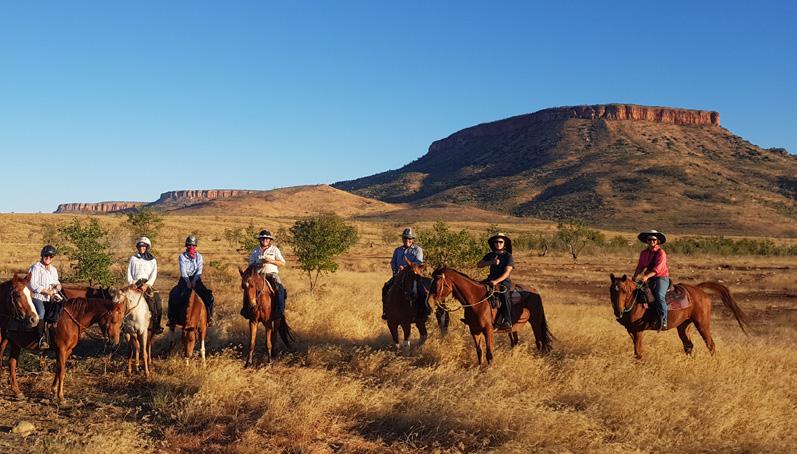
And there’s more!
You won’t be short of things to see and do when you visit the Kimberley:
y From the Five Rivers Lookout on the Bastion Range at Wyndham, you can see where the Durack, King, Pentecost, Forest, and Ord rivers converge and flow into the ocean - and the views of the
Kimberley, its coastline and vast flood plains are staggering.
y Located in the old Courthouse, the Wyndham History
Museum offers a fascinating glimpse into both the town’s history and the Kimberley’s pioneering days.
y Pioneering life in the Kimberley was far from easy, and the Pioneers’ Cemetery became the final resting place for many. Established in 1866, the cemetery testifies to the hardships of those early days.
y The Afghan Cemetery, resting place of Afghan camel drivers, offers another window into the region’s past. Camel teams of up to 70 beasts once travelled up to 25 miles a day in the arid outback with a single bull able to carry over half a tonne.
y A proud reminder of Wyndham’s Aboriginal heritage, the larger than life statues at the Warriu ‘Dreamtime’ Park in Koolama Street depict an Indigenous family, as well as a variety of native animals.
y Drive along the King River Road south of Wyndham, and you’ll find the Prison Tree, a hollow Boab thought to be 1,500 years old and once used by local police as a temporary lock up.
y Escape from the Kimberley’s heat at the Marlgu Billabong.
Located about 15 kilometres from Wyndham, the billabong is an all-year-round home to thousands of wetland birds, and not surprisingly, is a favourite haunt for bird watchers.
Caroline Price and her stallion Calavino. The pair won Champion 6-year-old at Dressage & Jumping with the Stars in 2018 (Image courtesy DJWTS).
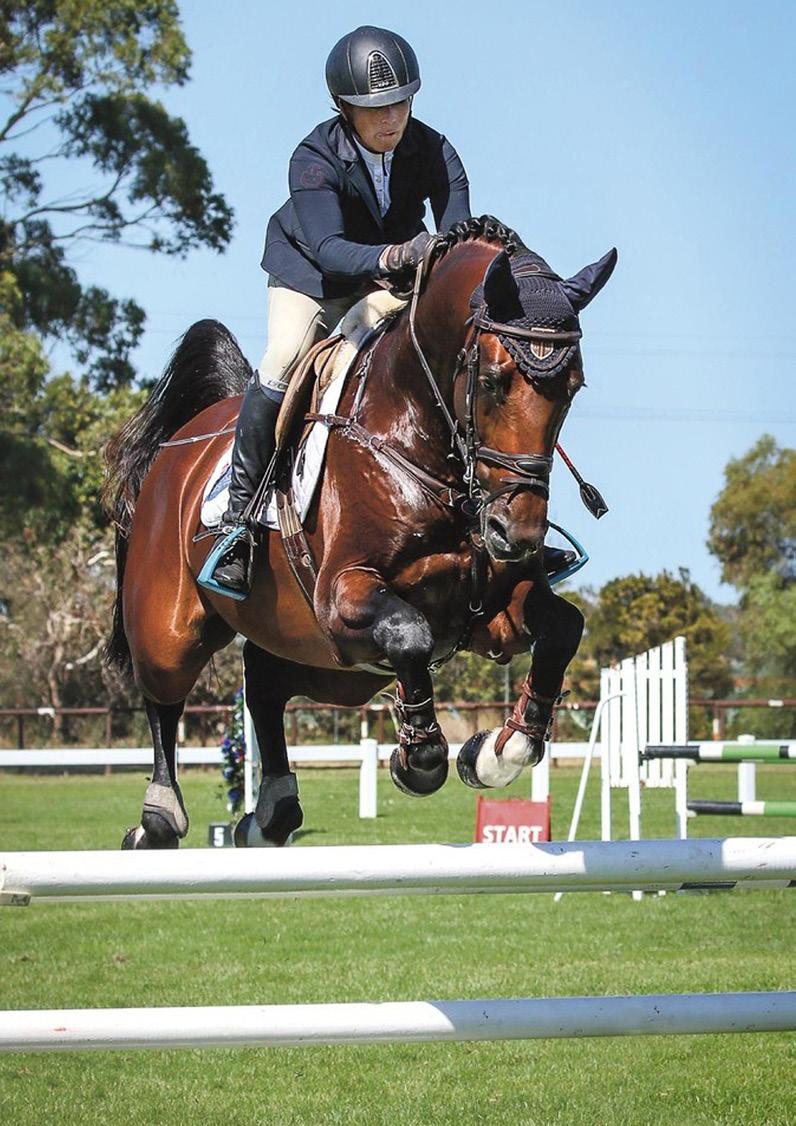
LIFE AFTER RACING
A new life
The Hong Kong horse racing industry relies heavily on the importation of horses, Australian Thoroughbreds among them. JO MCKINNON reports on a program designed to re-home retired racehorses.
Dozens of Australian Thoroughbreds are exported to Hong Kong each year for the multi-billion dollar horse racing industry that flourishes there.
With no breeding industry in Hong Kong itself horses are specially flown in on a regular basis to supply the 24 Hong Kong Jockey Club (HKJC) listed trainers with their racing stock.
Horses must quickly adapt in a hot pot of pressure. It’s a vastly different environment to the one they were accustomed to back home. There are no big open spaces and there’s no downtime from the rigours of racing life. Some cope with the intense, concrete jungle lifestyle - and some don’t.
Given such challenges, welfare is and always has been a major focus in Hong Kong. The HKJC proactively aims to ensure that owners take responsibility for their horses once their racing careers are over.
In recent years Amy Taylor, a passionate Australian equestrian now living in Hong Kong, has developed an exclusive Thoroughbred adoption program called International Thoroughbred Retirement (ITR), which is designed to provide clients with a service that delivers on horse welfare and wellbeing, with a strong focus on integrity. racehorse not just a new home, but a successful and healthy future, and as a part of that mission their adoption program is structured to ensure each horse receives re-education and is found a future home that suits its unique personality and attributes
Amy has personally dedicated her time to the re-homing and re-education of more than 100 Thoroughbred racehorses at Affinity Park, her Australian property. Her work was recognised in 2015 when she was awarded one of HH Sheikh Mohammad's Godolphin Awards for Thoroughbred Care and Welfare. Her focus has been on expanding the program by using her 13 years of experience in the racing industry as a jockey, trainer and owner to help give horses the best chance at a quality life off the track.
Linking a dedicated network of retrainers throughout Australia and New Zealand, the ITR program combines their efforts to achieve a diverse range of new careers depending upon the individual needs of the horse.
In March this year, one of Victoria’s leading show jumping riders, Caroline Price, was appointed as one of ITR’s exclusive re-trainers. Since then she has successfully re-homed eight horses and says it’s been an enormously satisfying journey.
“The most satisfying thing is seeing them go to a new home and knowing that you have placed that horse with that person and there’s a 99 per cent chance it will live there for
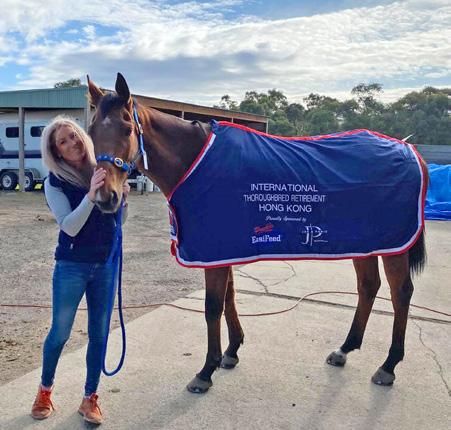
Caroline with My Darling, one of the Hong Kong racehorses she rehomed (Image courtesy Caroline Price).










